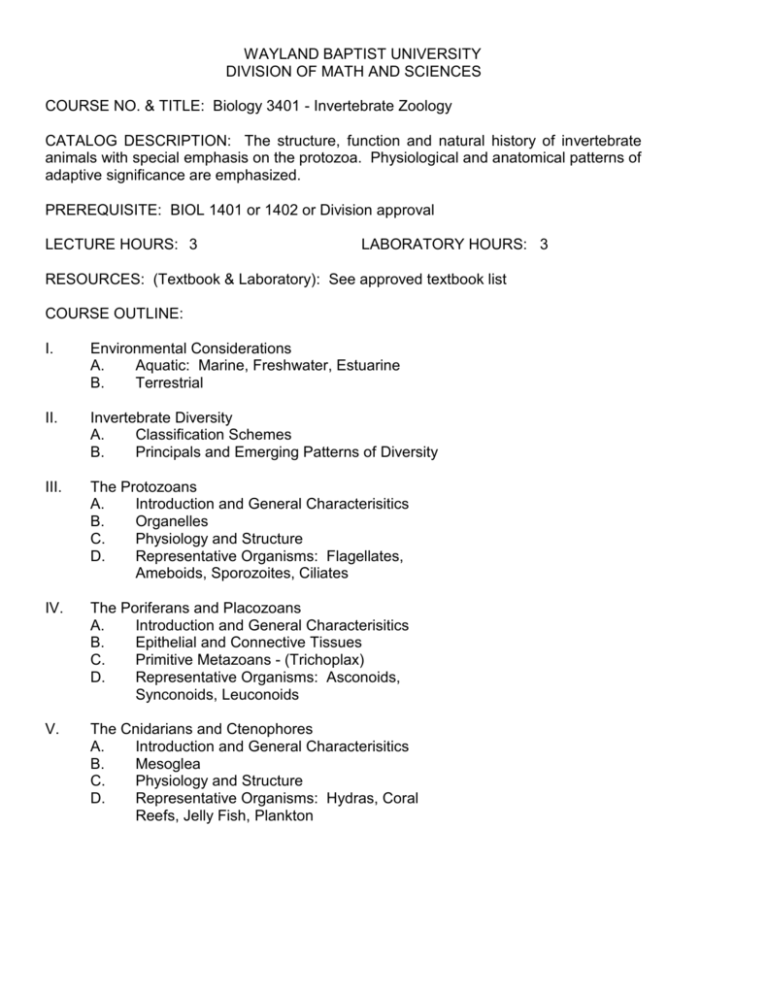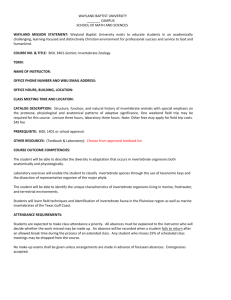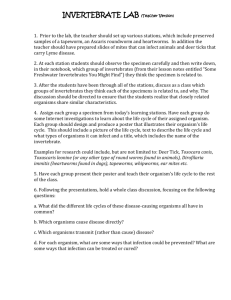Translated by WordPort from WordStar 3.x
advertisement

WAYLAND BAPTIST UNIVERSITY DIVISION OF MATH AND SCIENCES COURSE NO. & TITLE: Biology 3401 - Invertebrate Zoology CATALOG DESCRIPTION: The structure, function and natural history of invertebrate animals with special emphasis on the protozoa. Physiological and anatomical patterns of adaptive significance are emphasized. PREREQUISITE: BIOL 1401 or 1402 or Division approval LECTURE HOURS: 3 LABORATORY HOURS: 3 RESOURCES: (Textbook & Laboratory): See approved textbook list COURSE OUTLINE: I. Environmental Considerations A. Aquatic: Marine, Freshwater, Estuarine B. Terrestrial II. Invertebrate Diversity A. Classification Schemes B. Principals and Emerging Patterns of Diversity III. The Protozoans A. Introduction and General Characterisitics B. Organelles C. Physiology and Structure D. Representative Organisms: Flagellates, Ameboids, Sporozoites, Ciliates IV. The Poriferans and Placozoans A. Introduction and General Characterisitics B. Epithelial and Connective Tissues C. Primitive Metazoans - (Trichoplax) D. Representative Organisms: Asconoids, Synconoids, Leuconoids V. The Cnidarians and Ctenophores A. Introduction and General Characterisitics B. Mesoglea C. Physiology and Structure D. Representative Organisms: Hydras, Coral Reefs, Jelly Fish, Plankton VI. Bilateral Symmetry A. Movement B. Coelomic and Vascular Compartments C. Reproduction VII. The Platyhelminthes A. Introduction and General Characterisitics B. Hermaphroditic Versus Dioecious Reproductive Patterns C. Physiology and Strucuture D. Representative Organisms: Planaria, Tapeworms, Flukes VIII. The Nemertines And Nematodes A. Introduction and General Characterisitics B. Geographical Distribution C. Physiology and Structure D. Representative Parasitic Organisms: Ascaris, Hookworm, Guinea Worm, Filarial Worms IX. The Rotifers and Related Phyla A. Introduction and General Characteristics B. Freshwater Diversity in Morphology and Physiology C. Representative Organisms: Epiphanes senta X. The Annelids and Related Phyla A. Introduction and General Characteristics B. Morphology and Physiology of Segmentation C. Representative Organisms: Marine polychaetes, Leeches, Freshwater oligochaeta XI. The Mollusks A. Introduction and General Characteristics B. Morphology and Physiology C. Representative Organisms: Gastropoda, Prosobranchia, Bivalvilogy OUTCOME COMPETENCIES: The student will be able to describe the diversity in adaptation that occurs in invertebrate organisms both anatomically and physiologically. Laboratory exercises will enable the student to classify invertebrate species through the use of taxonomic keys and the dissection of representative organism of the major phyla. The student will be able to identify the unique characheristics of invertebrate organisms living in marine, freshwater, and terrestrial environments. COURSE EVALUATION: Exams: Lecture Exams Lab Exams Final Exam 40% 40% 20% University Grading System: A = 90 - 100 B = 80 - 89 C = 70 - 79 D = 60 - 69 F = BELOW 60 I = INCOMPLETE + W = WITHDRAWAL + A grade of incomplete is changed if the deficiency is made up by midterm of the next regular semester, otherwise, it becomes an "F". This grade is given only if circumstances beyond the student's control prevented completion of work during the semester enrolled and attendance requirements have been met. ATTENDANCE POLICY: Students are expected to make class attendance a priority. All absences must be explained to the instructor who will decide whether the work missed may be made up. An absence will be recorded when a student fails to return after an allowed break time during the process of an extended class. Any student who misses 25% of scheduled class meetings may be dropped from the course. No make-up exams shall be given unless arrangements are made in advance of foreseen absences. Emergencies accepted. NOTE: It is the university policy that no otherwise qualified disabled person be excluded from participation, be denied benefits of, or be subject to discrimination under any educational program or activity in the university. Student should inform the instructor of existing disabilities at the first class meeting. Rev. 11/05







